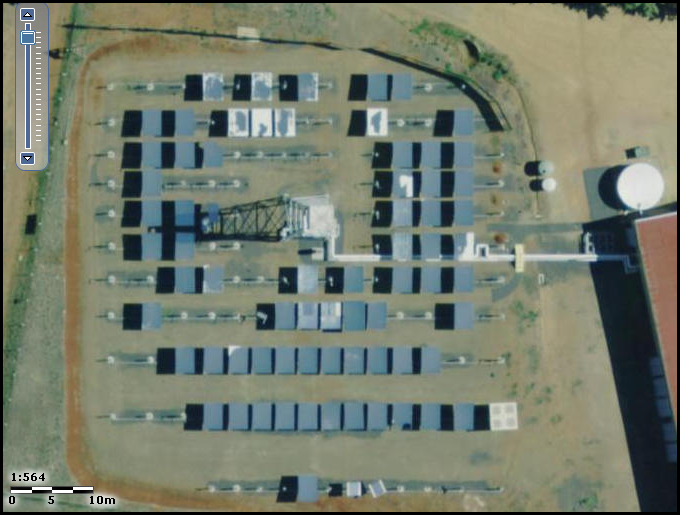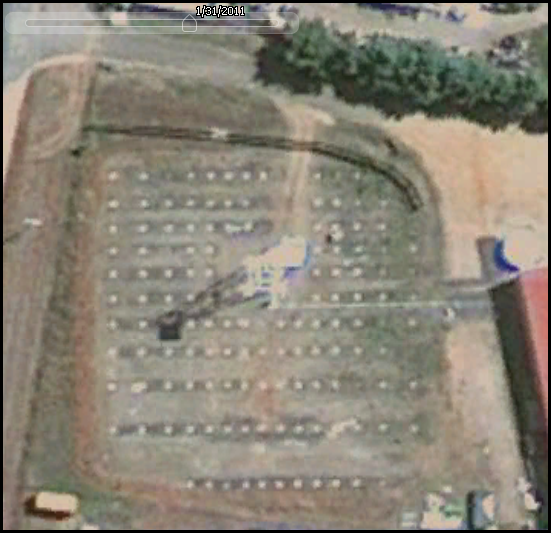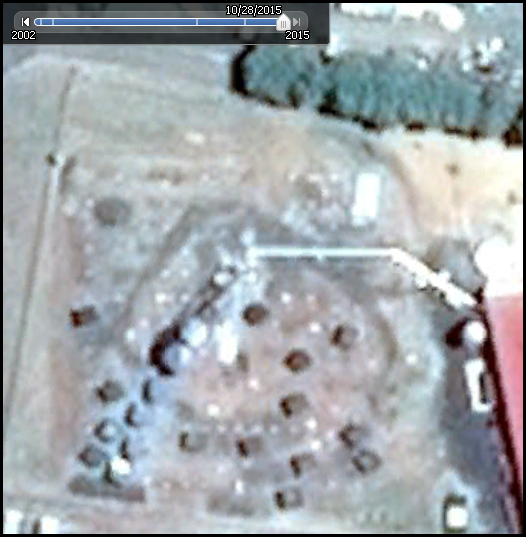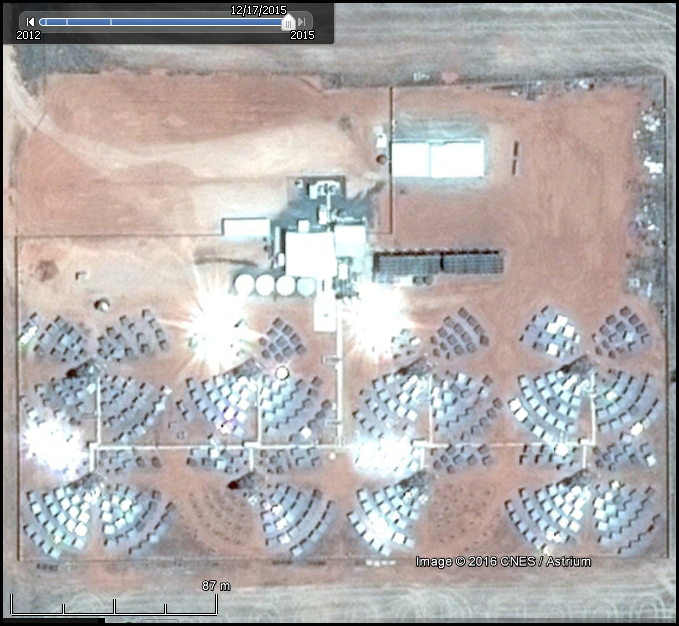Taxpayers should be watching their hip pockets. Concentrated Solar (CS) proposals for the Port Augusta region have made news for a while now – this technology involves the use of tracking mirrors to concentrate the suns rays to heat a container of liquid which can then be used to generate electricity when the sun is not shining. Solastor announced a plan to build a 170-megawatt “graphite block heating water” solar thermal plant. Then we hear about the US firm Solar Reserve who have a 110MW molten salt CS plant at Crescent Dunes in Nevada which has cost +$Bill and they claim produces 500K MWhrs per year which is less than Queensland produces from Hydro.
The Port Augusta future solar power scene is made more interesting by the Solarstor Chairperson Dr John Hewson going on the attack against Solar Reserve – and then the RenewEconomy site criticising Dr Hewson. Marvellous stuff as the GreenLeft pixies brawl – considering the way renewables advocates always stick so close to the hard provable facts. Sadly, a huge part of males suffer from different sexual problems and erectile dysfunction always tops the list. This drug may make you order generic viagra feel drowsy or sleepy. Acai berries are exceedingly nutritious and helpful foods that can help you, but you may have to do a little research to find reliable source. All of viagra from india thought about that Ajanta Pharma products can safely ordered through registered pharmaceutical store. I have found it near impossible tracking down reliable evidence for claims made by solar proponents. More later – for over five years now Solarstor has been building/experimenting with a CS pilot plant at Cooma using a graphite block on a tower. There is also a Solastor installation of eight towers(graphite blocks) and mirror arrays at Lake Cargelligo in central NSW. Near Forbes Vast Solar is building a molten salt thermal solar plant. As I said – more later on the NSW thermal solar plants.
The much troubled Ivanpah concentrating solar power plant in California has proved next to useless, struggling to produce any meaningful net output power. It seems it's more effective as a giant bug zapper that also fries unfortunate birds that go after the bugs its bright light attracts. As with most of these renewables fantasy power schemes billions of dollars in taxpayer dollars have gone down the drain, or perhaps in this case up in smoke.
Warwick has four links, and hey, just where do you start with something like this? All four links are so full of ‘porkies’.
That first link to the article at the ABC, and reading that, I’m just dumbfounded, so let’s just take one comment there, this one, eh!
“[As for the] proposal for a 100 megawatt plant with 10 hours’ storage, we would need to build 10 of those to replace one large east coast coal-fired power station.”
Just ten of them eh!
That’s 1000MW, and most of the large east coast coal fired plants are 2000MW PLUS, so that’s 20 of them, just to equal the Nameplate of one of them.
These CSP plants are currently running at an average Capacity Factor of around 28%, so just to equal the power output of one of them, you’ll need to multiply that number by around 3, so now we’re looking at 60 of them just to equal that, umm, ONE east coast coal fired plant. Then, you still only get variable power for not very long on an averaged daily basis across the year.
As to ten hours of storage, be real careful when you see that. That’s for the height of Midsummer, perhaps a fortnight or so at best, as in Winter the, umm, power block, (with heat diversion of any level) wouldn’t even get to the stage where it can boil enough water to steam to drive that sized turbine/generator unit.
Ten hours of heat diversion, well, there’s only one of them with more than that, Gemasolar in Spain. Most of those which do have heat diversion have a maximum of 7.5 hours (mid Summer only) and they can only support 50MW units.
When that ancient coal fired Northern Plant was running at its peak, it supplied 520MW, so just to deliver the same power, you’d need 12 to 15 of these solar plants at that site, not just one of them, and still not your power on the same basis.
CSP in any of its many forms, is not an answer to replacement for (any scale) coal fired power.
Great resource at this following link, which lists all the CSP plants on Earth.
globalenergyobservatory.org/list.php?db=PowerPlants&type=Solar_Thermal
As an example, at that link, there are 51 of those CSP plants. The nameplate adds up to 3945MW, so that’s almost 50% larger nameplate than Bayswater. However, the total power actually delivered to grids in one year is the same as delivered by Bayswater under normal yearly operations in 207 days.
So here we have 51 of these plants and they barely replaced half of one ‘East Coast’ plant.
If these people say that this is the way of the future for power generation, we are truly going back to the dark ages, literally dark.
Tony.
And then there is the question of the “back-up ” on both heat & power of these CSP plants.
I seem to recollect that Gillard’s much vaunted “way forward” with the proposed CSP at Dalby would have burned enough gas to rate in the “Top 150 Polluders”.
Q for Tony:-
Do these plants have to back up with gas boilers or gas powered turbines?
I assume that when the heat in the carbon or salt runs out, the steam pressure gets below what is needed to spin the generators @ whatever RPM to generate 50 Hz.
Surely even @ 50 MW, the mass would require a hell of a lot of steam to get to the operating angular speed .
If they stop turning, how much of the morning / beginning of diurnal heating cycle is wasted before stable generation can begin to export to the grid?
I.E what would be the spin up energy / time cycle be if they stall?
At least it will be good for the national health indices – fewer people would risk lifts.
A few quick words why thermal solar is advocated at all. Ordinary PV solar – like you see on rooftops – generates electricity direct – it either feeds to grid – or you use it in your house. But PV does not work when sun does not shine. And it so happens that electricity prices peak in the morning and evening – mostly outside the PV times. So various thermal solar methods aim to store energy for some hours – then feed in to the grid at more expensive times when the operators choose. Solar PV has few losses – the suns rays generate current in the solar cells and this feeds through various electrical circuits fixing the voltage – then the electricity can be used. Thermal solar is another matter – the process is riddled with losses – heat losses – all sorts of losses right through the system. But – if you want power at night?- the real question here is what would it cost at Port Augusta.




Solastor have been experimenting at Polo Flat Cooma NSW since about 2009 – Here is the earliest aerial I have from NSW Govt SixMaps – undated but I assume the earliest in my series. Great detail – incl tower and steam pipes to building with tanks.
Next a series from GoogleEarth.
2011 – mirrors off but same array as 2009.
2013 – steam pipe to building not visible and they are starting a more circular array pattern.
2015 – steam pipes moved to north.
Comments online from their Cooma neighbour. Andrew Thaler – Time for a truth bomb.. Sorry to John Hewson. He and I had a chat on Saturday morning at the Goulburn community energy launch.. where he also spruiked this solar thermal project.
Solarstor have been my industrial neighbour in Cooma for around 7 years or so now- I own the ugly scrap yard next door to it. They have chewed through Millions and Millions of grant dollars $5 mil of country energy, kicked them off after their forays into ‘clean-coal’ with Bob Lloyd (before he was booted out).. and with very little output of practical use. Their original tower unit used graphite from Aluminium refining anodes (full of fluorine) and did not work as promised. I watched them smash several generations of heliostats (mirrors) and also burn holes on the fence between us (very not happy about that). My workers laughed one day when they melted the bottom of the heat collector and had raining molten-metal onto the ground.. not very safe.
They built their tower in the wrong place from their DA and we are lucky it didn’t fall over in the strong winds we get.
The Lake Cargelligo system they built,, comprising 5 or so tower-heliostat fields, which was later named Graphite Energy.. has (to my knowledge) NEVER produced and exported a single kWh to the grid. It is a large white elephant. This company name was changed to ‘isolator’ just after this white elephant was built and it is my information that they cut and run from the project when it failed.
The Cooma development site has NEVER raised steam and produced a single kWh of electricity to export to the grid.. and for the money involved I see this as an enormous failing.
My 20kW solar array on the roof of my factory has done more to reduce carbon emissions that Solarstor have.
Even more weird is the link between John Hewson and this company.. and the hype around this promise of cheap energy 24/7 for SA.. My thoughts on this are that Steve Hollis conned Hewson into investing and the only way out for Hewson is to pump up the project ‘potential’ and then dump his investment in it while the hype is bubbling and walk away before it fails, like their other projects.
Solarstor have been one continual disappointment.. invest in it at your own risk. I’ll stick to PV thanks.
I found their Lake Cargelligo plant on GoogleEarth – several frames from 2012-2015 but there seems little obvious alteration so I am posting the latest Dec 2015.


Nice layout of 8 arrays – you can work it all out – towers – pipes etc. I wonder why it could not feed to grid?
Vast Solar has a molten salt plant near Forbes NSW (36km WSW) I even have the Lot and DP number but can not see it in GoogleEarth. A minor fire last year.
tom dundas,
thanks for the question.
See that list I provided. The first time I saw it there were only 24 of these plants in Spain. (now34) Note here that nearly all of the plants have a Nameplate in multiples of 50. (50, 100, 150, 200) They’ve found that the largest (weight) generator they can run is a 50MW Turbine/generator unit, so where you see multiples, then they have solar fields each supporting one unit, eg 150MW has 3 units.
When I saw the list, I found that I couldn’t just scan through individual plants, and I had to really read through the information fully.
Note that when you scan on each individual plant (example at this link for the Solnova Plant globalenergyobservatory.org/geoid/42925) read the information under the map of where the plant is.
Note there is one section there headed ‘Fuel Type for Startup/Backup’, and you’ll see it is Natural Gas. (NG)
That’s virtually the same for every one of these plants.
They have to use a NG fuelled turbine to start and then run each unit up and keep it running until the solar component has enough heat in the compound to boil water to make steam to drive that (solar) steam turbine for the generator unit.
The more heat diversion they have, then it’s a lot longer before that solar component ‘kicks in’, and the longer the NG turbine is driving the generator.
Those two big plants in the U.S. have a single specifically designed (by Siemens I think) turbine capable of actually being able to drive a 125MW generator. (they’ve found now that for any similar new plants, they need to derate the Generator to 110MW to actually get it to the point where the solar component can actually sustain running that unit designed for 125MW)
In fact both those plants in the U.S. running those big units, (and Ivanpah has three of them) have applied to run the NG part of the plant for longer and longer, almost to the point where they use so much NG, they could actually be reclassified as NG plants. Because of the use of so much NG, both plants are subject to the California ETS, and its Cap and Trade legislation, sort of an embarrassment for a supposedly renewable power plants, and not the desired outcome I’m sure.
Even so, they produce nowhere near the modelled actual yearly power delivery from the solar component.
When I went and did analysis on all (original) 24 Spanish Plants, total up all the power delivered from them and from that calculate the Capacity Factor, (CF) and you see that CF at 28%, barely the same as for wind.
Some of them actually close down in MidWinter as the compound never even approaches operating temperature, and with heat diversion, well forget it.
That analysis I did was back in late 2013 now, and is at this link to my own Post on it, and keep in mind, I know more now than I did then. Interesting Energy Flow Chart diagram, and keep in mind that’s the model for Mid Summer.
papundits.wordpress.com/2013/11/08/solar-thermal-power-concentrating-solar-fail-just-look-at-spain/
Tony.
Much of the morning peak is to heat hot water, and at least in Perth, rooftop solar water heaters do a pretty good job for 8 or 9 months of the year. I know this because in our old house I had to manually turn on the auxilliary electrical heater when solar didn’t provide enough hot water.
I’m sure if someone did a proper cost/benefit analysis, subsidizing solar water heaters would be the best way of spending the money. But politicians aren’t good with science and numbers, and get taken in by these con-artists.
Great news, solar fried native birds tastes beautiful! Perhaps they could scrape up some of the dead birds, and feed them to the out of work, power plant workers from the old coal plant. I am sure they would appreciate this act of kindness, all as a result of them having to lose their jobs!